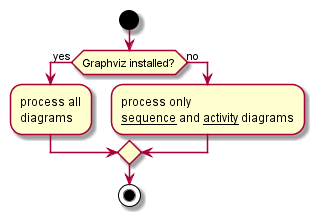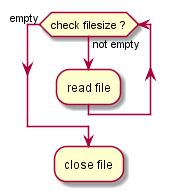第一部分:活动图语法
(1)简单活动图:活动标签(activity label)以冒号开始,以分号结束。活动默认安装它们定义的顺序就行连接。
1 @startuml 2 :Hello world; 3 :This is on defined on 4 several **lines**; 5 @enduml
(2)开始/结束:你可以使用关键字start和stop表示图示的开始和结束。
1 @startuml 2 start 3 :Hello world; 4 :This is on defined on 5 several **lines**; 6 stop 7 @enduml
@startuml start :Hello world; :This is on defined on several **lines**; end @enduml
(3)条件语句:在图示中可以使用关键字if,then和else设置分支测试。标注文字则放在括号中。
@startuml start if (Graphviz installed?) then (yes) :process all\ndiagrams; else (no) :process only __sequence__ and __activity__ diagrams; endif stop @enduml
@startuml start if (condition A) then (yes) :Text 1; elseif (condition B) then (yes) :Text 2; stop elseif (condition C) then (yes) :Text 3; elseif (condition D) then (yes) :Text 4; else (nothing) :Text else; endif stop @enduml
(4)重复循环:你可以使用关键字repeat和repeatwhile进行重复循环。
@startuml start repeat :read data; :generate diagrams; repeat while (more data?) stop @enduml
(5)while循环:可以使用关键字while和end while进行while循环。还可以在关键字endwhile后添加标注,还有一种方式是使用关键字is。
@startuml start while (data available?) :read data; :generate diagrams; endwhile stop @enduml
@startuml while (check filesize ?) is (not empty) :read file; endwhile (empty) :close file; @enduml
(6)并行处理:你可以使用关键字fork,fork again和end fork表示并行处理。
@startuml start if (multiprocessor?) then (yes) fork :Treatment 1; fork again :Treatment 2; end fork else (monoproc) :Treatment 1; :Treatment 2; endif @enduml
(7)注释:
@startuml start :foo1; floating note left: This is a note :foo2; note right This note is on several //lines// and can contain HTML ==== * Calling the method ""foo()"" is prohibited end note stop @enduml
(8)箭头:
使用->标记,你可以给箭头添加文字或者修改箭头颜色。同时,你也可以选择点状 (dotted),条状(dashed),加粗或者是隐式箭头
@startuml :foo1; -> You can put text on arrows; if (test) then -[#blue]-> :foo2; -[#green,dashed]-> The text can also be on several lines and **very** long...; :foo3; else -[#black,dotted]-> :foo4; endif -[#gray,bold]-> :foo5; @enduml
(9)连接器(Connector):可以使用括号定义连接器。
@startuml
start
:Some activity;
(A)
detach
(A)
:Other activity;
@enduml
(10)组合(grouping):通过定义分区(partition),你可以把多个活动组合(group)在一起。
@startuml start partition Initialization { :read config file; :init internal variable; } partition Running { :wait for user interaction; :print information; } stop @enduml
(11)分离(detach):可以使用关键字detach移除箭头。
@startuml :start; fork :foo1; :foo2; fork again :foo3; detach endfork if (foo4) then :foo5; detach endif :foo6; detach :foo7; stop @enduml
(12)特殊领域语言(SDL):通过修改活动标签最后的分号分隔符(;),可以为活动设置不同的形状。
@startuml :Ready; :next(o)| :Receiving; split :nak(i)< :ack(o)> split again :ack(i)< :next(o) on several line| :i := i + 1] :ack(o)> split again :err(i)< :nak(o)> split again :foo/ split again :i > 5} stop end split :finish; @enduml
第二部分:分析《超市购物》系统
-
超市购物系统拥有三个部分:顾客、收银员、收款机。
-
顾客进入商店,选择自己所要购买的商品,并把选好的商品拿到收银台交给收银员。
-
收银员询问顾客是否是会员,如果是会员,索要顾客的会员卡,把会员卡扫描进系统并对会员卡进行验证。
-
然后逐一扫描顾客所选商品的条形码,收款机边接收商品条码,边累加商品金额。
-
扫描完商品信息后,收银员根据收款机上显示的商品金额收货款,然后通过收款机打印售货单。
-
最后收银员把售货单和商品交给顾客,本次购物过程结束。
第三部分:《超市购物》活动图
1 @startuml 2 start 3 :选择商品; 4 :商品交给收银员; 5 if (是否是会员) then (会员) 6 :扫描会员卡; 7 if (是否有效) then (无效) 8 :提示会员卡无效; 9 else (有效) 10 :提示会员卡有效; 11 endif 12 :扫描商品条码; 13 14 else (非会员) 15 :扫描商品条码; 16 endif 17 :接收商品条码; 18 :统计商品金额; 19 while(还有商品否?) is (有) 20 :扫描商品条码; 21 endwhile (无) 22 :交付货款; 23 :接受货款; 24 :打印售货单; 25 :货单及货品交给顾客; 26 :接受货单及货品; 27 28 29 stop 30 @enduml















